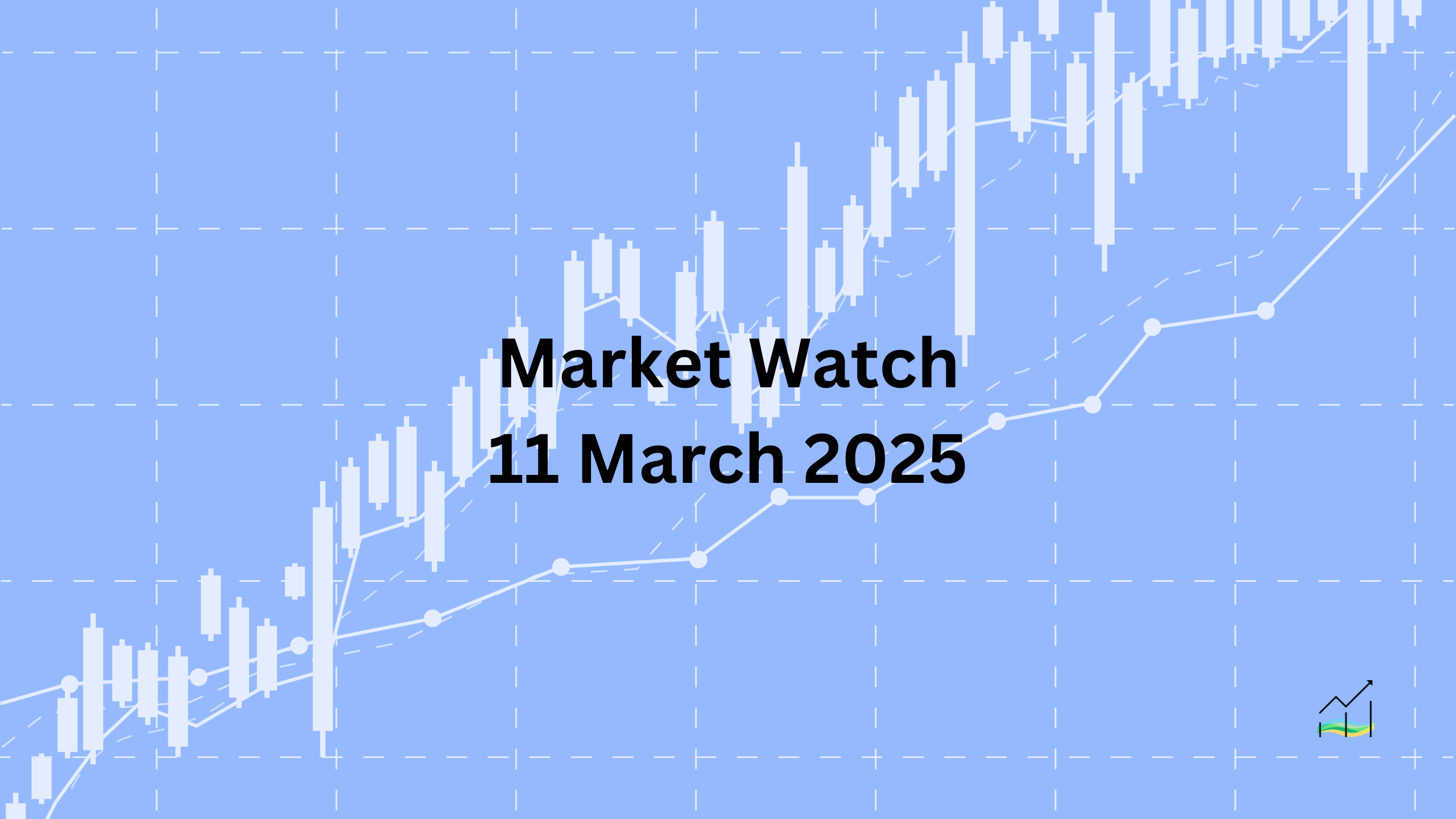11/03/2025 Market Watch

Political Developments & Market Reactions
Political developments in Germany have signaled progress toward an agreement on defense spending, which has pressured the US dollar lower. The euro has regained its post-election losses, supported by a narrowing US-Eurozone interest rate differential. Meanwhile, Japan reported disappointing economic data, with weaker household spending and a downward revision to Q4 GDP, which has weighed on the yen and Swiss franc. The euro’s strength has also boosted central European currencies, while the Chinese yuan edged higher, and the Mexican peso remained stable.
In equity markets, a sharp sell-off in US stocks has led at least 10 corporations to postpone investment-grade bond sales. However, US index futures are showing some recovery, with the Nasdaq up 0.6% and the S&P 500 gaining 0.3%. European stocks continue their losing streak, with the Stoxx 600 declining for a fourth consecutive session. In Asia, most major indices, including Japan and Taiwan, fell more than 1%, except for Chinese stocks, which posted gains on both the mainland and in Hong Kong.
Bond yields have reacted to these developments, with Japanese and Australian 10-year yields dropping by six basis points, while European yields climbed 2-5 basis points on German political news. UK gilts remained flat, and the US 10-year yield softened near 4.20%. In commodities, gold is rebounding to around $2,910 after briefly dipping to $2,880. Meanwhile, April WTI crude oil tested last week’s low near $65.20 before recovering to around $66.50 in late European trading.
United States of America
Overview
The US dollar has undergone a significant decline, driven by concerns over US economic growth and reduced risks in Europe. The Dollar Index has dropped 6% since its peak before President Trump’s second inauguration, erasing a key portion of its previous rally. Despite recovering slightly in North American trading, the index failed to stay above 104.00 for the first time since the election. If the decline continues, the next key support level is around 102.00.
Economic Drivers
Several factors are influencing the market sentiment:
- US Growth Fears: Concerns over slowing economic momentum have pressured the dollar.
- European Stability: Reduced uncertainty in Europe has strengthened the euro.
- Stock Market Sell-Off: The sharp drop in US equities has contributed to broader risk aversion.
- Lower US Bond Yields: Declining yields have weakened the dollar’s appeal.
- Policy Uncertainty: Potential US steel and aluminum tariffs, as well as political developments, add to market caution.
Data and Events
Key reports and events impacting the market include:
- Small Business Optimism: Confidence levels have declined, reversing gains from expected tax cuts and deregulation.
- JOLTS Labor Report: Market participants are watching hiring trends for signs of economic strength.
- Inflation Data (CPI): Scheduled for tomorrow, CPI figures could influence Federal Reserve policy expectations.
- Trade Policy Risks: Uncertainty remains around possible US tariffs on steel and aluminum.
- Government Shutdown Risk: Avoiding a shutdown by the end of the week will require bipartisan support.
Price Action
The Dollar Index tested new lows near 103.40, marking its weakest level since the election. A further drop could push it towards 102.00. Despite the US stock market’s sharp decline and falling bond yields, the dollar saw temporary strength in North American trading but failed to hold above 104.00.
Key Points:
- The Dollar Index has fallen 6% since its peak before Trump’s second inauguration.
- European stability and US growth concerns have pressured the dollar.
- Lower US bond yields and stock market weakness add to bearish sentiment.
- Key data includes business optimism, labor market reports, and inflation figures.
- A potential US government shutdown and tariff threats remain key risks.
- If the dollar breaks below 103.35, the next key support level is 102.00.
Canada
Overview
Tensions between the US and Canada have escalated, with reports suggesting the US is considering removing Canada from the "Five Eyes" intelligence-sharing group. Additionally, nearly all threatened tariffs apply to Canada, fueling uncertainty. The Canadian dollar has struggled this year, making it the worst-performing G10 currency, while the Australian dollar is the second worst. Meanwhile, the US dollar has continued its recovery against the Canadian dollar after hitting a low last week.
Economic Drivers
Key factors influencing market movements include:
- US-Canada Trade Tensions: Tariff threats and political friction add to uncertainty.
- Weak Canadian Dollar: The currency has underperformed, declining nearly 0.25% this year.
- Global Currency Trends: The Australian dollar, though weak, has still gained 1.6% against the US dollar.
- Bank of Canada Policy: Markets are pricing in an interest rate cut at the upcoming policy meeting.
- US Dollar Strength: The dollar’s upward momentum against the Canadian dollar continues.
Data and Events
Market-moving developments include:
- US-Canada Trade Relations: Reports indicate rising tensions, with potential intelligence-sharing changes.
- Tariff Policies: Canada remains the primary target of US tariff threats.
- Bank of Canada Meeting: Markets expect a rate cut with a 95% probability.
- Interest Rate Expectations: Two additional rate cuts are already priced in for the year.
- US Dollar Movement: The greenback has been recovering against the Canadian dollar after last week's low.
Price Action
The US dollar has extended its recovery against the Canadian dollar, climbing from CAD1.4240 last Thursday to nearly CAD1.4475. Today’s range remains tight between CAD1.4410 and CAD1.4450, with a key trendline resistance near CAD1.4500. Market focus is on the Bank of Canada’s decision, which could influence further price movement.
Key Points:
- US-Canada relations remain strained, with trade and intelligence-sharing at risk.
- The Canadian dollar is the worst-performing G10 currency this year.
- The US dollar continues to strengthen against the Canadian dollar.
- The Bank of Canada is expected to cut rates, with more cuts already priced in.
- The next resistance level for USD/CAD is around CAD1.4500.
China
Overview
The US dollar is testing the lower end of last week’s range against the offshore yuan (CNH), with key support levels approaching. The 200-day moving average near CNH7.2220 has held since last November. Meanwhile, China has launched a CNY1 trillion (~$138 billion) initiative to boost AI and quantum computing. Reports indicate the US may cancel Biden’s chip program, creating potential strategic shifts. Speculation is also growing about a possible mid-year Trump-Xi summit.
Economic Drivers
Several factors are influencing currency and policy dynamics:
- Yuan Stability: Chinese officials appear satisfied with the yuan’s performance against the US dollar.
- US Policy Uncertainty: The potential cancellation of Biden’s chip program may impact tech competition.
- China’s Tech Investments: A major AI and quantum computing fund strengthens China’s innovation push.
- Geopolitical Positioning: Beijing may take advantage of any US hesitation or policy shifts.
- Trump-Xi Meeting Speculation: A possible mid-year summit could influence market sentiment.
Data and Events
Key market developments include:
- Yuan Exchange Rate: The US dollar is testing critical support levels near CNH7.2220.
- PBOC’s Reference Rate: The yuan’s daily fix has risen slightly for three consecutive sessions.
- US Chip Policy: Reports suggest the US may end Biden’s chip program, impacting semiconductor markets.
- China’s AI Investment: A CNY1 trillion public-private fund has been announced to boost tech innovation.
- US-China Diplomatic Moves: Talks of a Trump-Xi summit could shape future economic relations.
Price Action
The dollar is nearing key support levels against the yuan, testing CNH7.2280, with last month’s low at CNH7.2260 and the 200-day moving average at CNH7.2220. The yuan’s reference rate has edged higher for three consecutive sessions, now at CNY7.1741, marking the largest three-day increase in nearly four months.
Key Points:
- The US dollar is testing key support levels against the yuan.
- China’s officials remain comfortable with the yuan’s stability.
- The potential cancellation of Biden’s chip program could reshape US-China tech competition.
- China has announced a CNY1 trillion investment in AI and quantum computing.
- Market speculation is growing around a potential Trump-Xi summit.
- The yuan’s reference rate has risen for three straight days, the largest move in months.
Europe
Overview
The euro climbed above $1.09 in early European trading after reports that the German Greens are willing to negotiate on defense spending with the CDU and SPD. This shift, along with European fiscal measures and US growth concerns, has significantly reduced the likelihood of the euro falling to parity. Market positioning reflects this change, with speculative short positions shrinking for three consecutive weeks. Meanwhile, Greenland is holding legislative elections, which, while not a major market event, are drawing attention due to US interests in the region.
Economic Drivers
Several factors are influencing market sentiment:
- German Political Developments: The Greens’ willingness to negotiate on defense spending supports the euro.
- European Fiscal Policy: Stimulus measures are reducing economic risks.
- US Growth Concerns: Slowing momentum in the US economy is weakening the dollar’s appeal.
- Shifts in Market Positioning: Speculative short positions on the euro have declined for three weeks.
- Yield Differentials: The US-German two-year bond spread has narrowed by 60 basis points in a month.
Data and Events
Key market-related events include:
- Euro Gains: The currency has risen above $1.09, approaching last November’s high of $1.0935.
- Commitment of Traders Report: Speculative short positions in the euro are at their lowest since last November.
- US-German Yield Spread: The two-year premium has dropped to 165 basis points, levels last seen in October.
- Greenland Elections: While not market-moving, the elections are attracting attention due to geopolitical interests.
- Euro Parity Unlikely: Futures and options markets suggest the risk of the euro falling to parity has diminished.
Price Action
The euro has gained strength, surpassing $1.09 and nearing key resistance at $1.0935. Market sentiment has shifted, reflecting reduced concerns about parity. The US-German two-year yield spread has tightened, further supporting the euro’s upward momentum.
Key Points:
- The euro rose above $1.09 after German political developments.
- Market expectations of the euro falling to parity have diminished.
- Speculative short positions on the euro are at their lowest in months.
- The US-German two-year bond yield spread has narrowed significantly.
- Greenland’s elections are drawing attention but are not a market-moving event.
Japan
Overview
The US dollar fell to a five-month low against the yen, nearing JPY146.55, with little support until JPY145. A decline in US Treasury yields and disappointing economic data contributed to the yen’s strength. The US-Japan bond yield spread has narrowed significantly, reaching its lowest level since August 2022. Meanwhile, Japan’s economic data underperformed, with weaker-than-expected household spending and a downward revision to Q4 GDP growth.
Economic Drivers
Several key factors are influencing currency movements:
- US Bond Yields: The US 10-year yield fell to 4.15% before recovering slightly, after briefly dipping below 4.20% yesterday.
- Japan’s Economic Data: Household spending rose only 0.8% year-over-year in January, far below the expected 3.7%.
- Revised Japanese GDP: Q4 GDP growth was revised down to 2.2% annualized from 2.8%.
- US-Japan Yield Spread: The 10-year premium over Japan has dropped to 265 basis points, down from 357 basis points in mid-January.
- BOJ Rate Hike Expectations: Market odds of a June rate hike have fallen to 50%, with a full hike now expected in October instead of September.
Data and Events
Key market-moving developments include:
- Dollar-Yen Movement: The dollar fell to JPY146.55, its lowest level in five months, with last week’s high near JPY151.30.
- US 10-Year Yield: Declined nine basis points yesterday and briefly dropped to 4.15% today before recovering.
- Japan’s Household Spending: Increased 0.8% year-over-year, significantly missing the 3.7% forecast.
- Japan’s GDP Revision: Q4 GDP growth was downgraded to 2.2% from an earlier estimate of 2.8%.
- Rate Hike Expectations: BOJ rate hike odds for June have been cut to 50%, with expectations shifting toward October.
Price Action
The dollar continues to weaken against the yen, dropping from last week’s high of JPY151.30 to JPY146.55, with potential support near JPY145. The US 10-year yield, which briefly dipped to 4.15%, remains a key driver. The narrowing yield gap between the US and Japan is adding to the yen’s strength, with market sentiment shifting toward a longer timeline for BOJ policy changes.
Key Points:
- The dollar hit a five-month low against the yen at JPY146.55.
- US 10-year yields dropped, briefly falling below 4.20%.
- Japan’s economic data disappointed, with weak household spending and lower Q4 GDP growth.
- The US-Japan yield spread has narrowed to its lowest level since August 2022.
- Market expectations for a BOJ rate hike have been pushed back from September to October.
United Kingdom
Overview
The British pound surged 2.55% in the first three sessions last week, briefly surpassing $1.29 and reaching $1.2945 before reversing lower. Despite a minor dip, it held above $1.2860 and is now testing recent highs. Meanwhile, the euro made significant gains against sterling, posting its strongest weekly advance in two years as German yields rose relative to UK yields.
Economic Drivers
Several key factors are influencing currency movements:
- Sterling’s Strong Performance: The pound saw a sharp rally but faced resistance near $1.2945.
- UK Economic Calendar: Limited key data releases this week, with focus on house prices and GDP.
- German-UK Yield Spread: Rising German bond yields relative to UK yields have supported euro strength.
- Euro Recovery: After hitting multi-month lows against sterling, the euro rebounded sharply.
- Market Positioning: Traders have reacted to shifting rate differentials between the UK and Eurozone.
Data and Events
Key upcoming reports that could influence market movements:
- RICS House Price Data: Scheduled for release tomorrow, providing insights into the UK housing market.
- January UK GDP Report: Due at the end of the week, offering a clearer picture of economic momentum.
- Euro’s Weekly Surge: Gained 1.6% against sterling last week, marking its largest rise in two years.
- Euro’s Highs Against Sterling: Reached GBP0.8445 today, nearing this year’s peak of GBP0.8475.
- Sterling’s Support Level: Held yesterday’s low of $1.2860, keeping the uptrend intact for now.
Price Action
Sterling’s rally encountered resistance near $1.2945, leading to a pullback. The euro, after hitting a multi-month low near GBP0.8240 in early March, staged a strong recovery, climbing to GBP0.8445 today. The currency pair’s momentum remains driven by shifting yield spreads and market sentiment.
Key Points:
- The British pound surged 2.55% last week but faced resistance near $1.2945.
- Limited UK economic data this week, with focus on house prices and GDP.
- German bond yields rising relative to UK yields have strengthened the euro.
- The euro saw its biggest weekly gain against sterling in two years.
- The euro is approaching key resistance levels near GBP0.8475.
- Sterling’s support is holding at $1.2860, keeping short-term trends in focus.
© 2025 SKONE Enterprise (003319453-V). All rights reserved.
The content on this site is for informational purposes only and does not constitute financial advice.


